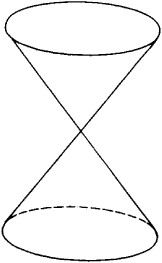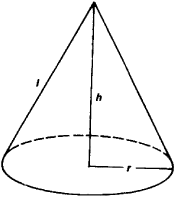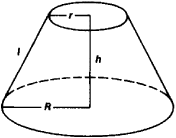cone
cone
[kōn]wind cone

Cone
(mathematics). (1) A cone, or conical surface, is the locus of lines (generators) in space that join all the points of a curve (directrix) to a given point (vertex) in space. If the directrix is a line, then the cone reduces to a plane. If the directrix is a curve

of the second degree not lying in the same plane as the vertex, then we obtain a quadric conical surface (see Figure 1, where the directrix is an ellipse). The simplest surface of this type is a circular, or right circular, cone, whose directrix is a circle and whose vertex can be orthogonally projected to the center of the circle.


(2) In elementary geometry, a circular cone is a geometric solid bounded by the surface of a circular cone and the plane containing the directing circle (Figure 2). Its volume is equal to πr2h/3, and its lateral area to πrl If a cone is cut by a second plane parallel to the first, a frustum of the cone (Figure 3) is obtained, whose volume is equal to π(R2 + r2 + Rr)h/3 and whose lateral area is π(R + r)l.